|
A Way With the Manger
Creches Become
Collectible Folk Art
by Bob Brooke
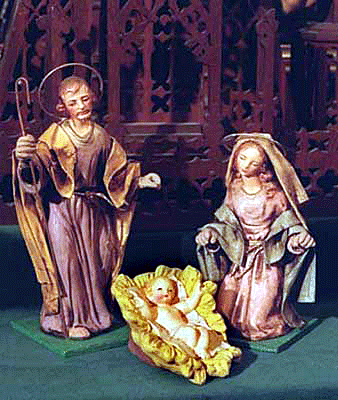 Although
many other stories and symbols have been gathered into the rich treasury
of Christmas lore, the Nativity remains the central image of the
holiday, the reason for its being. For centuries the scene described in
the Gospels—the babe in his humble crib, the holy parents beside him,
the shepherds and barnyard animals staring amazed while three
resplendent kings kneel in adoration—has moved people of all faiths. No
wonder it has long been customary to recreate this scene at Christmas
time. Although
many other stories and symbols have been gathered into the rich treasury
of Christmas lore, the Nativity remains the central image of the
holiday, the reason for its being. For centuries the scene described in
the Gospels—the babe in his humble crib, the holy parents beside him,
the shepherds and barnyard animals staring amazed while three
resplendent kings kneel in adoration—has moved people of all faiths. No
wonder it has long been customary to recreate this scene at Christmas
time.
Nativity scenes gained popularity in the 17th century, promoted by the
Capuchin, Jesuit and Franciscan orders. By the 18th century, three
centers of crèche culture had emerged—Naples, Italy, Provence, France,
and southern Germany and Austria.
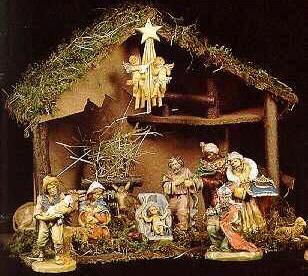 Over
the years, the Nativity has been portrayed in many ways. In America, the
most popular form is the crèche, a word meaning "manger" or
"crib" in French. Carved from wood—although some makers use ceramics,
glass, straw, fabric, or even plastic—and painted, a crèche usually
depicts the entire Nativity scene, including the manger, a star, angels,
shepherds, kings and the Holy Family. Although most are miniature in
scale, a few church crèches are almost life-size. Over
the years, the Nativity has been portrayed in many ways. In America, the
most popular form is the crèche, a word meaning "manger" or
"crib" in French. Carved from wood—although some makers use ceramics,
glass, straw, fabric, or even plastic—and painted, a crèche usually
depicts the entire Nativity scene, including the manger, a star, angels,
shepherds, kings and the Holy Family. Although most are miniature in
scale, a few church crèches are almost life-size.
The Origin of the Crèche
Although he didn’t originate the idea, historians credit St. Francis of
Assisi with popularizing the Nativity scene. From Italy, the idea spread
north across the Alps and finally came to the U.S. with German settlers.
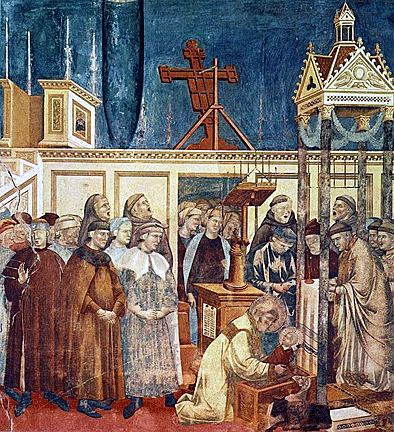 Supposedly,
a rich man, Giovanni Vellita, approached St. Francis in December, 1223,
asking how he could serve God. St. Francis told him to build a simple,
little stable just outside Assisi in the cave at Greccio. This was a
time when the average man learned about his faith from the plays he
watched, the songs he heard, and the art that lined the walls of the
churches. Supposedly,
a rich man, Giovanni Vellita, approached St. Francis in December, 1223,
asking how he could serve God. St. Francis told him to build a simple,
little stable just outside Assisi in the cave at Greccio. This was a
time when the average man learned about his faith from the plays he
watched, the songs he heard, and the art that lined the walls of the
churches.
Much of the celebration of Christmas occurred in churches for a long
time. The common worker, much less the very poor, weren’t given much of
a place in these celebrations. St. Francis wanted to give the poor
people a chance to celebrate. And so the story goes, as midnight
approached that Christmas Eve, a great procession wound its way out of
Assisi and up the hill to Greccio. Everyone came carrying candles to
this new manger they had built for the Holy Child. They celebrated mass
that night. Surrounded by an ox and a donkey and by the people of
Assisi, all playing the parts of the shepherds and folk of Bethlehem.
Long after St. Francis died, the people of Italy continued to build
stables for the Christ Child. Among wealthy Italian families, the simple
manger became something incredibly magnificent, the grand Italian
Presepio. Naples became the center of the biggest presepi
workshops. By the 18th century, these crèches took up whole rooms,
indeed, sometimes whole floors of great homes. People traveled from
villa to villa to visit and admire these incredible displays, which
often took months and a great deal of money to complete.
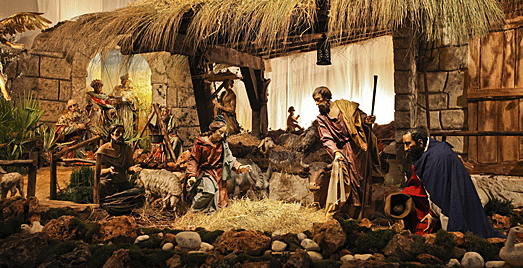
Sancta Maria Ad Praesepe, later to become the Basilica Santa Maria
Maggiore in Rome, contains the first recorded free standing set of
creche figures, sculpted from stone by Amolfo Di Cambio in 1282. For
some time after, nearly all the creches made were life-sized stone or
wood. Those in Tyrolean churches had statues with elaborate Baroque
costumes. At the same time, inexpensive Nativity scenes made out of
painted paper became available to those who couldn’t afford carved
figures.
What Goes Into a Crèche?
Artisans construct crèches or Nativity sets from a variety of materials.
The characters can be carved from wood, formed from wax, papier-mache,
or clay, or hand painted on cardboard. They stand in or in front of
buildings, ranging from Alpine stables and guest houses to romantic
Roman ruins. Others have Middle Eastern-style structures with minarets
and domes.
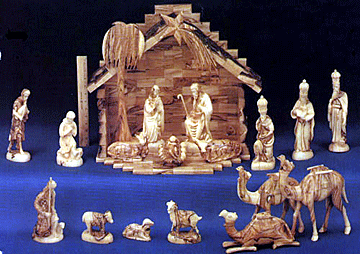 Many
crèches stand in front of a painted background. Indeed, some artists
have achieved fame in painting these scenes. Some show pastoral
hillsides and others are a continuation of the buildings in an imagined
city of Bethlehem. Many
crèches stand in front of a painted background. Indeed, some artists
have achieved fame in painting these scenes. Some show pastoral
hillsides and others are a continuation of the buildings in an imagined
city of Bethlehem.
The Italian presepio is a large diorama—much like a scale
model—of an Italian hill town. The greatest sculptors, architects,
jewelers and dressmakers of the 18th century made them. The figures
often stood about 20 inches high and were possable. In fact, craftsmen
often portrayed an entire village. They included trees, hills, butcher
shops, winemakers, carpenters, potters, old people, children and, of
course, angels. In some, there were great processions of elaborately
costumed dignitaries, camels, elephants, horses and musicians. In
addition, there were thieves, drunkards and beggars of the town—the
message being that Jesus came to save all men. At the center of it all
was the Holy Family and the manger, itself, with the Child Jesus.
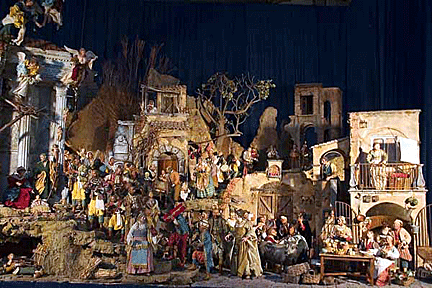 Many
Italian crèches placed the Holy Family in an old temple or castle,
usually represented as a ruin, with broken pillars or archways. This was
an historical statement, that the old culture had been destroyed and a
new history was beginning. The French generally placed the Holy Family
within an entire village, usually clustered on the top of a hill with
narrow streets and houses of bricks and mortar, populated by butchers,
bakers, millers and even the mayor. Many
Italian crèches placed the Holy Family in an old temple or castle,
usually represented as a ruin, with broken pillars or archways. This was
an historical statement, that the old culture had been destroyed and a
new history was beginning. The French generally placed the Holy Family
within an entire village, usually clustered on the top of a hill with
narrow streets and houses of bricks and mortar, populated by butchers,
bakers, millers and even the mayor.
The presepi became the passion of wealthy families. They spent
vast sums building and collecting them. To this day, collections are
named for the families who acquired and/or commissioned them. At
Christmas, the rich and the notable of the time traveled from house to
house to admire each other’s great displays. These collections sometimes
had hundreds of figures. They might take up whole rooms or floors of a
house. One such was that of King Charles III, which had 5,950 figures.
Over time, people broke up these great dioramas and sold off the
figures. Today, there isn’t one entire original collection that remains
intact. This grand Christmas custom died out before the end of the 19th
century. Most presepi today have only a few figures in them and
are kept in small ornate cases.
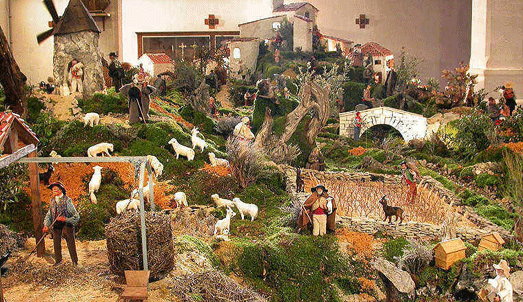
Italy’s crèche making hasn’t been limited to the grand presepi.
In southern Italy, artisans still make terra cotta santon, which
have become the crèches of most southern Italian families. Some displays
still get quite large, but the materials and execution are simpler.
Figures had flexible wire bodies covered with hemp with faces of painted
terra cotta. They made those in the distance smaller. And laid out
entire villages in carefully posed and well-staged vignettes. The
villagers in them wore costumes not from Bethlehem but from Italy.
Scenes contained people, places and activities of everyday life.
Santon are also the crèches of most households in southern France.
Like the Nativity figures of Italy, the French santon can either
be costumed, in real clothes of regional fabrics or santon habille,
or be painted and sculpted clay figures or santon d’argile.
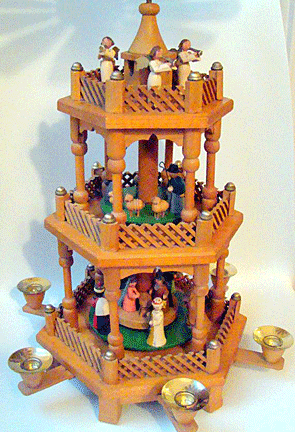 From
the alpine region of Italy, Bavarian Germany, Austria and Switzerland
come crèche figures carved from wood. They’re stained with paint and
beautifully carved. German crèches , often called krippen, and
can be made of cast metal, cast painted plaster, cardboard with painted
or printed artwork, turned wood or clay. Each Christmas, in scenes made
up of rocks, branches, evergreens and moss collected in the woods by the
family’s children just before the holiday, the krippe is reborn.
Christmas morning finds these scenes around the base of the family’s
Christmas tree in what’s called a putz or tree yard. From
the alpine region of Italy, Bavarian Germany, Austria and Switzerland
come crèche figures carved from wood. They’re stained with paint and
beautifully carved. German crèches , often called krippen, and
can be made of cast metal, cast painted plaster, cardboard with painted
or printed artwork, turned wood or clay. Each Christmas, in scenes made
up of rocks, branches, evergreens and moss collected in the woods by the
family’s children just before the holiday, the krippe is reborn.
Christmas morning finds these scenes around the base of the family’s
Christmas tree in what’s called a putz or tree yard.
A common figure in Province Nativity scenes is the Ravi, "the exalted
one." Portrayed on his knees with arms reaching to heaven, he’s the
village fool who is the only one who actually expresses in posture and
expression the ecstatic joy he has at the time of the Nativity. Only the
fool is able to be truly wise.
Germans and Austrians commonly included the landscape in their crèches.
They had mountains, rivers and valleys, and related to that, a city or a
castle that was the symbol of heavenly Jerusalem. An apple tree laden
with ripe fruit was also a part of the German/Austrian tradition. It's
an expression of new life. In the midst of winter darkness, you have an
apple tree with ripe apples. A monk, representing St. Jerome, is often
included in these crèches.
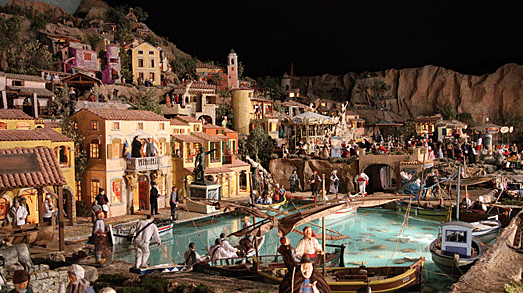
Crèches Worldwide
Today, craftsmen and artisans around the world construct crèches. From
Hungary come wonderful layered felt figures and a craft called straw
spinning. From the river Ganges in India, come figures of brightly
painted carved wood. From all over Africa, come nativities of straw,
carved nuts, wood and painted bark. From Ireland, come crèches carved
out of black peat.
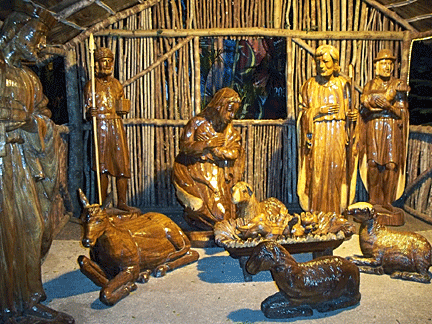 Ornate
crèches from precious materials weren’t limited to Europe. Flipinos call
their crèche a belen. Individual figures are santos. The
Christ Child, when He’s shown alone and asleep, is the Ninos Dormidos or
sleeping child. Many of these crèche s are quite simple and are of
carved wood but like those in Naples some crèche figures are incredibly
elaborate. They might be jointed, with glass eyes and hair or be made in
part or all out of ivory. Very often, they wear elegant gowns of
embroidered silks. They often have multiple changes of wardrobe. Ornate
crèches from precious materials weren’t limited to Europe. Flipinos call
their crèche a belen. Individual figures are santos. The
Christ Child, when He’s shown alone and asleep, is the Ninos Dormidos or
sleeping child. Many of these crèche s are quite simple and are of
carved wood but like those in Naples some crèche figures are incredibly
elaborate. They might be jointed, with glass eyes and hair or be made in
part or all out of ivory. Very often, they wear elegant gowns of
embroidered silks. They often have multiple changes of wardrobe.
All over the Southwest, Mexico and South America, influences of the
Spanish and Portuguese are evident in Nativity sets. Whether it’s the
hand carved santos in Niches of punched tin, the processional
candelabras with tiny figures in tableaus of the Nativity, crèche
figures of bread dough or woven straw, the celebration of Christ’s birth
is alive and vibrant here. Among these crèches can be found tiny
sorpresas, meaning surprise—a tiny church or dove which, when lifted
up, reveals figures less than 1/4-inch high. Best known are the brightly
painted clay figures with halos of wire tipped with balls of clay. In
addition, there are the brightly painted carved wooden figures from
Oaxaca, Mexico.
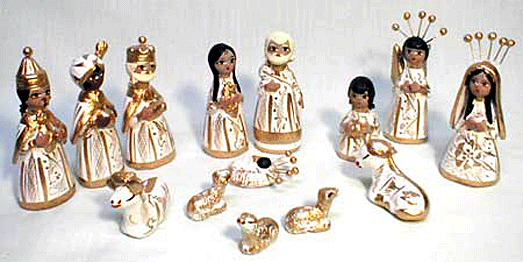
Collecting Crèches
Called a crèche in France, presipio in Italy, nacimiento
in Spain and Mexico and a
krippe in German-speaking countries, the crèches that people
collect vary as much as their origins.
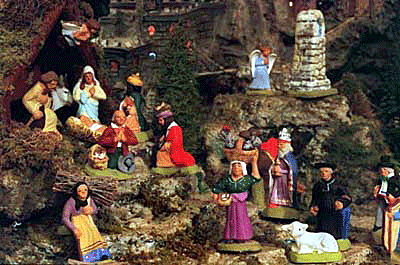 For
many, collecting crèches is an act of faith. Their crèches provide an
expression of their Christianity. Mormons are great collectors of
crèches. Creating a Nativity scene in a church has been a long-standing
tradition among Catholics And there has been increasing interest in
collecting Nativity sets among Protestants. For
many, collecting crèches is an act of faith. Their crèches provide an
expression of their Christianity. Mormons are great collectors of
crèches. Creating a Nativity scene in a church has been a long-standing
tradition among Catholics And there has been increasing interest in
collecting Nativity sets among Protestants.
But mostly, people collect crèches because they’re personal, a
reflection of intimate family life. They’re about humanity, not
religious dogma or ritual. Moving Nativity sets from the church to the
home has made them a popular art form.
The area around Provence, France, is the heart of the Nativity figure,
or santon, industry. In the early 19th century, a group of
Italian peddlers traveled to Marseille where they sold brightly painted
clay figures in the city’s streets and markets. The local artisans were
so delighted with the figures that they began to make santons,
too, costumed in the French dress of that period. Their work has
developed into some of the finest in the world.
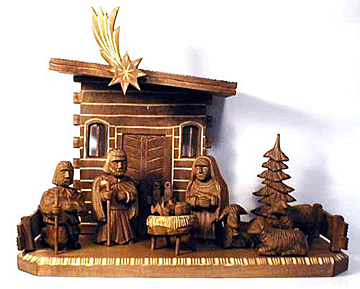 Today,
vendors sell santon in markets in Marseilles and other French cities, as
well as in Rome and in old Naples on the street of Via San Gregorio
Armeno near the Piazza San Gaetano And in Austria and Germany, vendors
at annual markets called Chriskindlemarkt sell Nativity figures.
Collectors go to them looking for one or two more figures or whole sets
to add to their crèche collections. Today,
vendors sell santon in markets in Marseilles and other French cities, as
well as in Rome and in old Naples on the street of Via San Gregorio
Armeno near the Piazza San Gaetano And in Austria and Germany, vendors
at annual markets called Chriskindlemarkt sell Nativity figures.
Collectors go to them looking for one or two more figures or whole sets
to add to their crèche collections.
Nativity sets and crèches vary in value, from some worth over $1,100 to
others worth just $5. But for many collectors, their value is intrinsic.
They’re also easy to find and buy, which makes them fun to collect. At
one point, the Ruby Lane site on the Internet had no less then 300 sets
for sale.
To read
more of my articles, please
visit
my Web site.
< Back
to Collectibles Archives Next Article >
|
